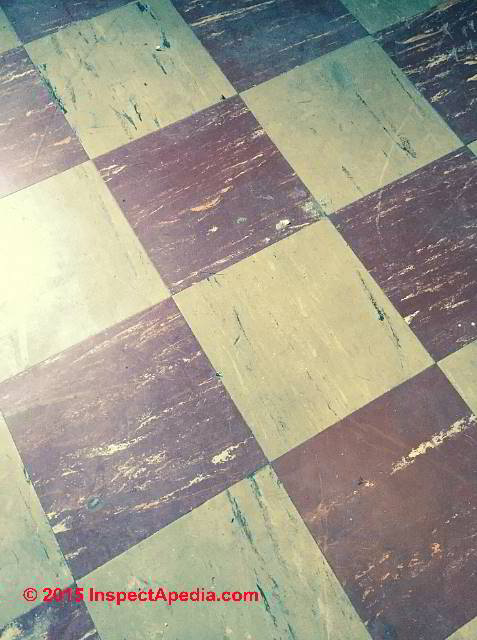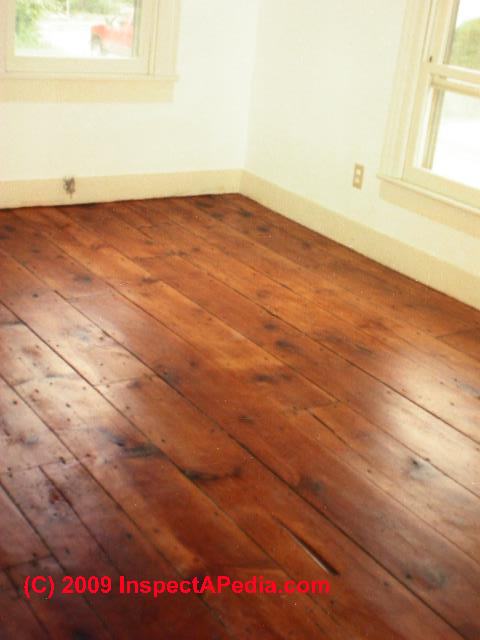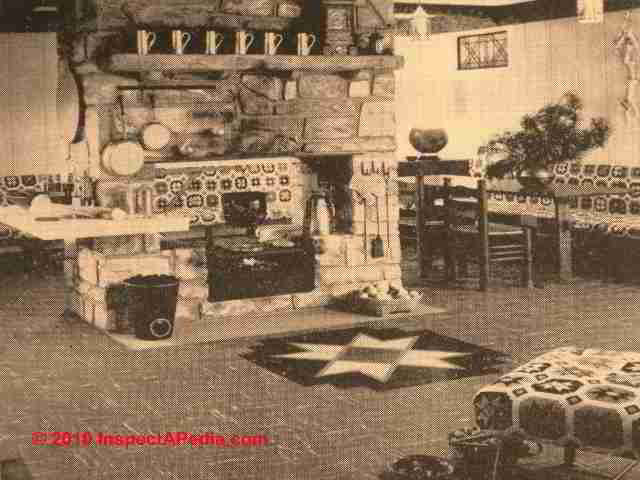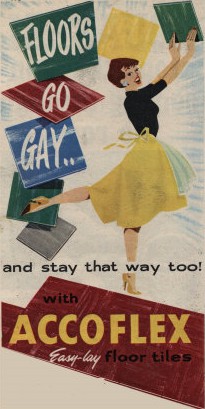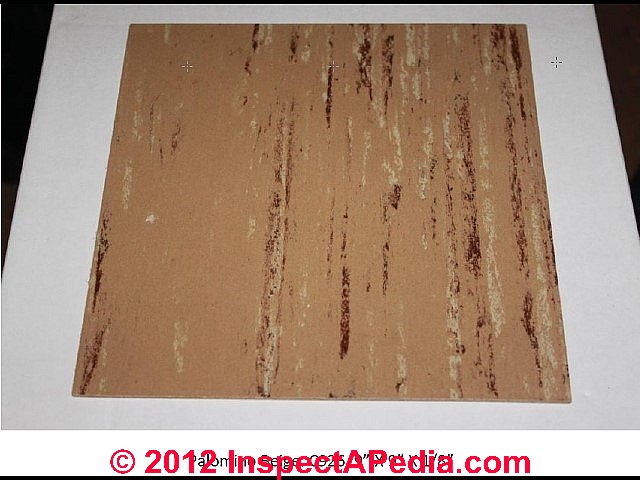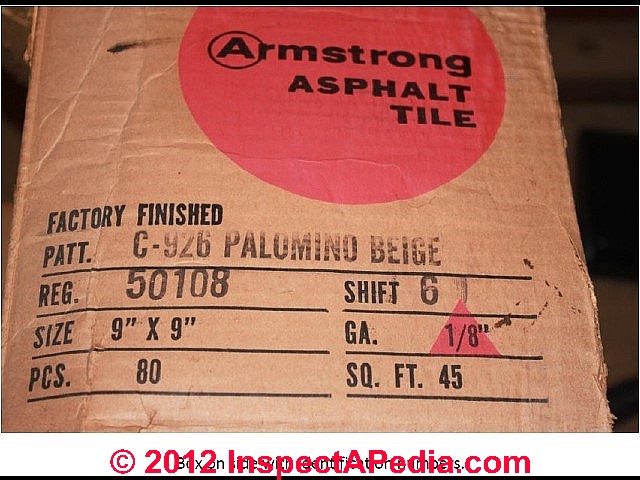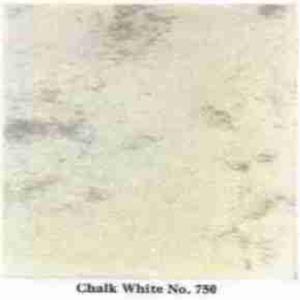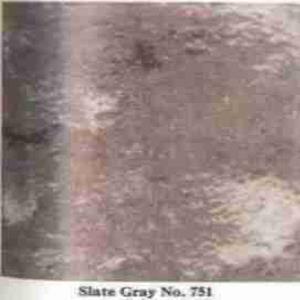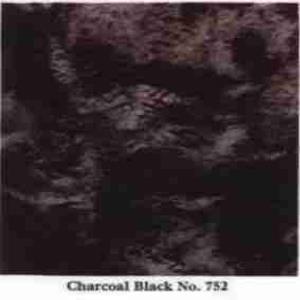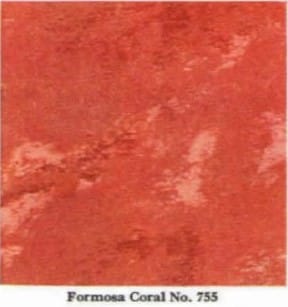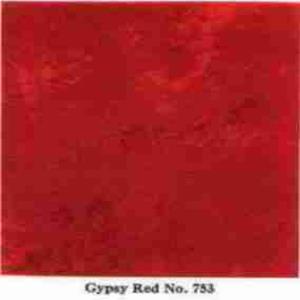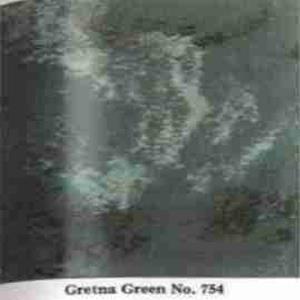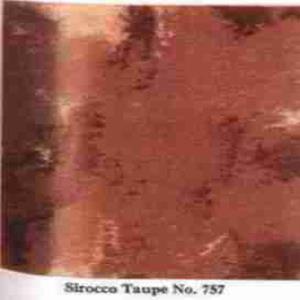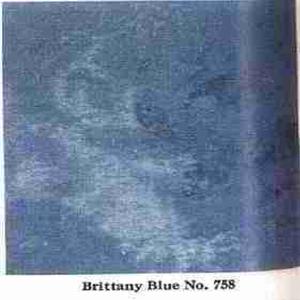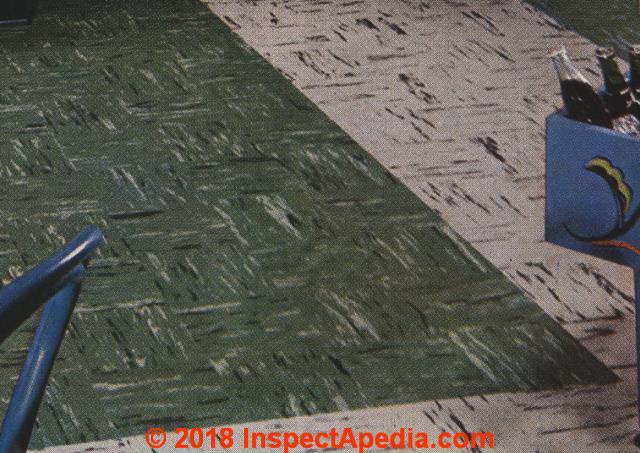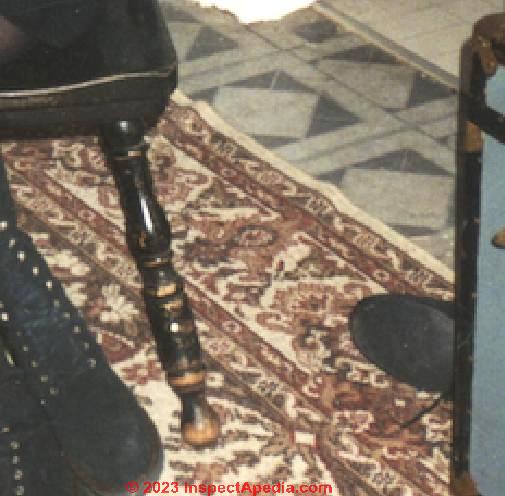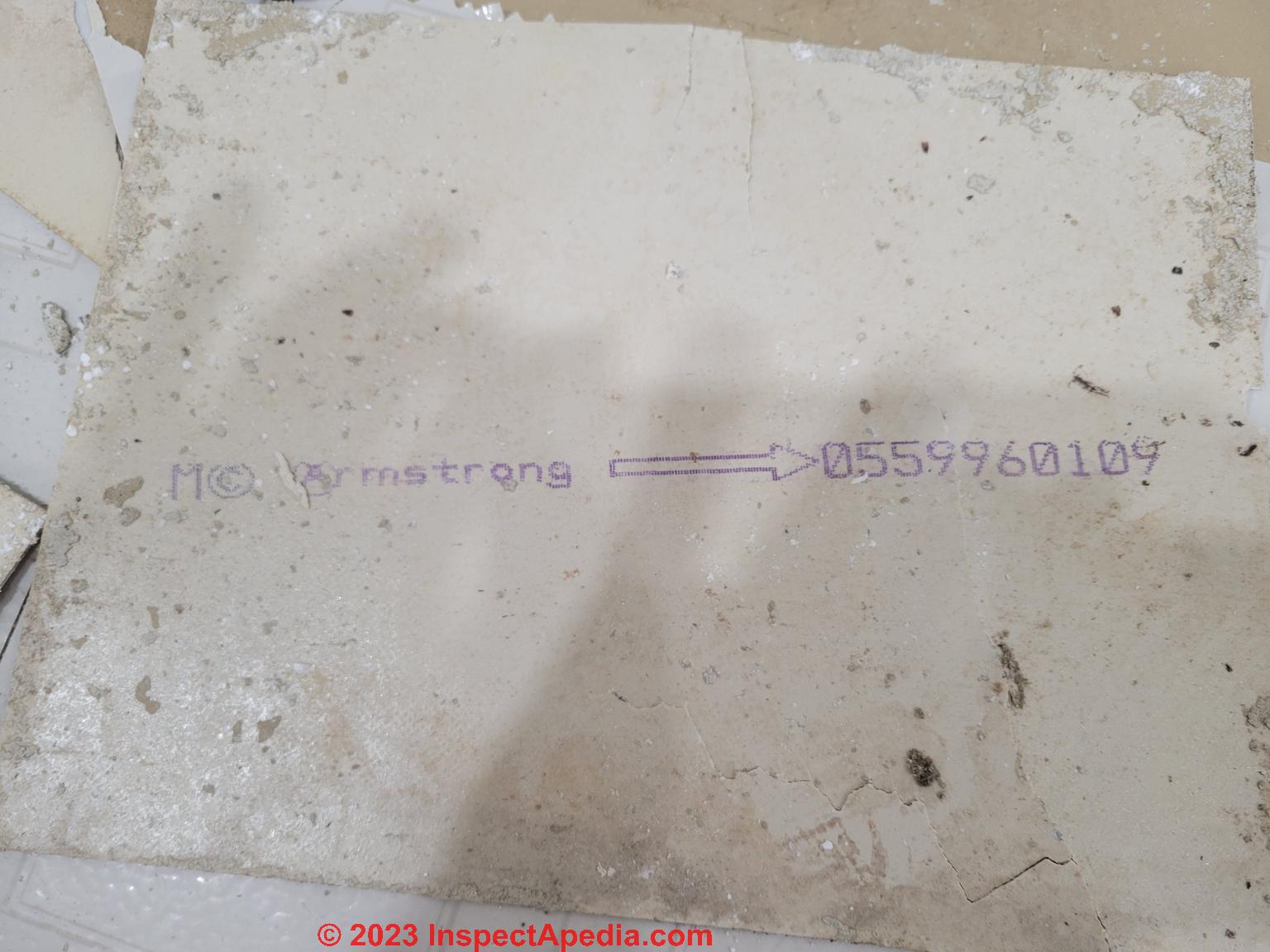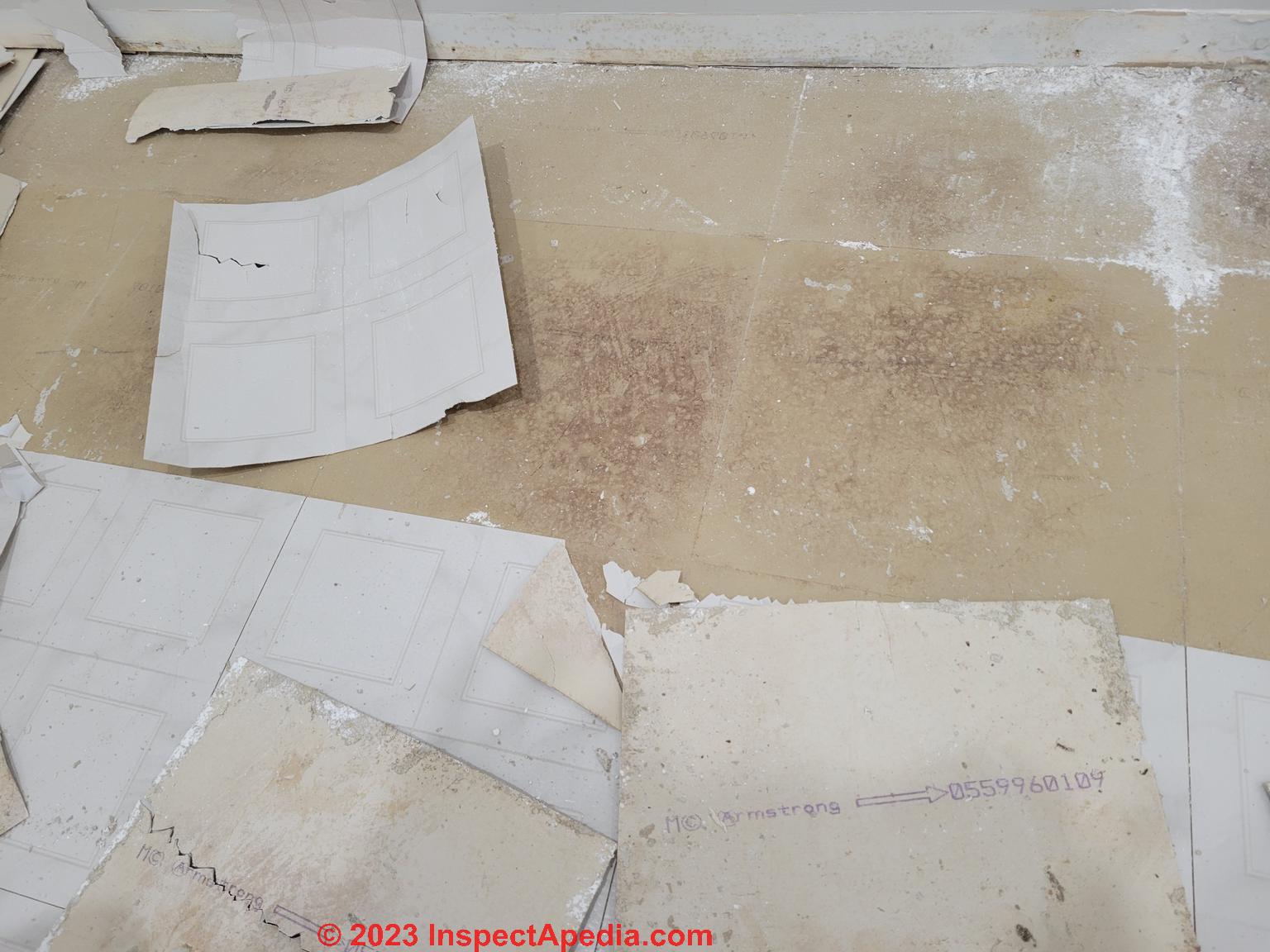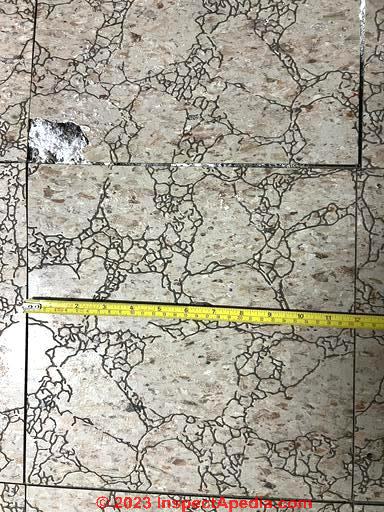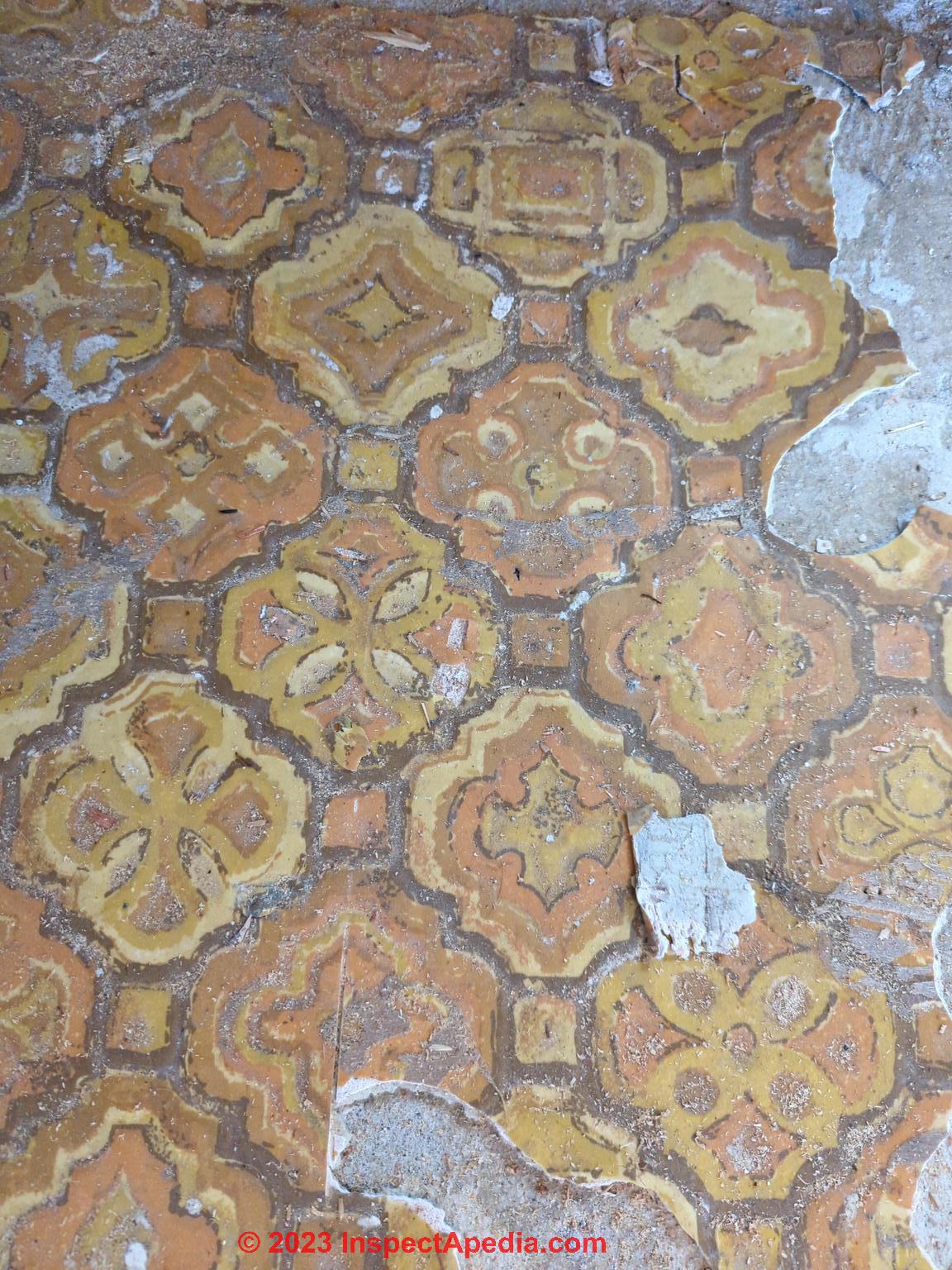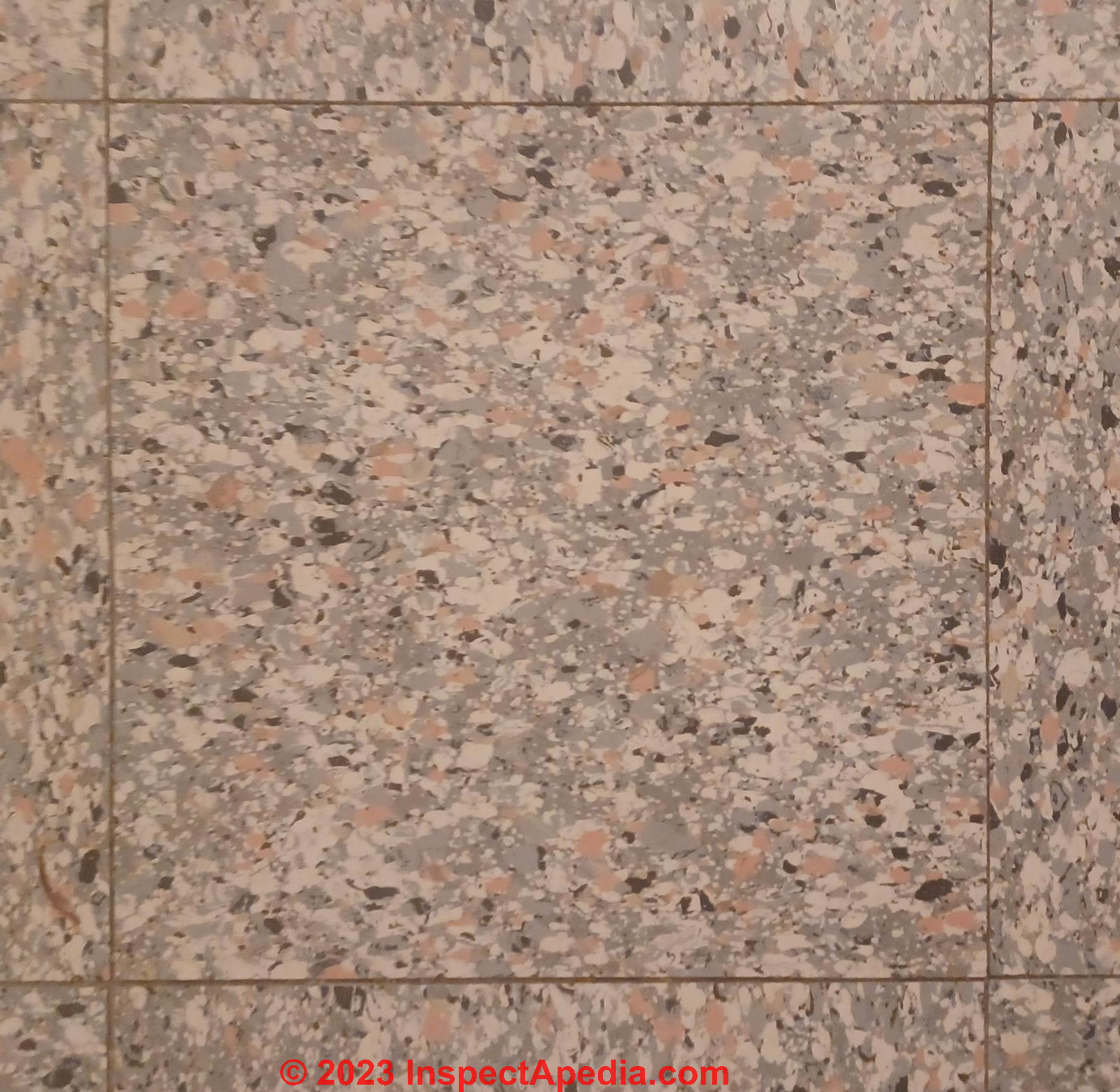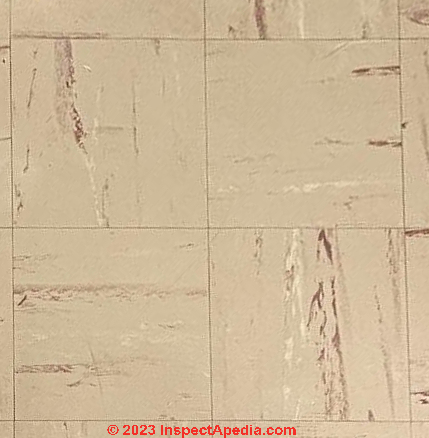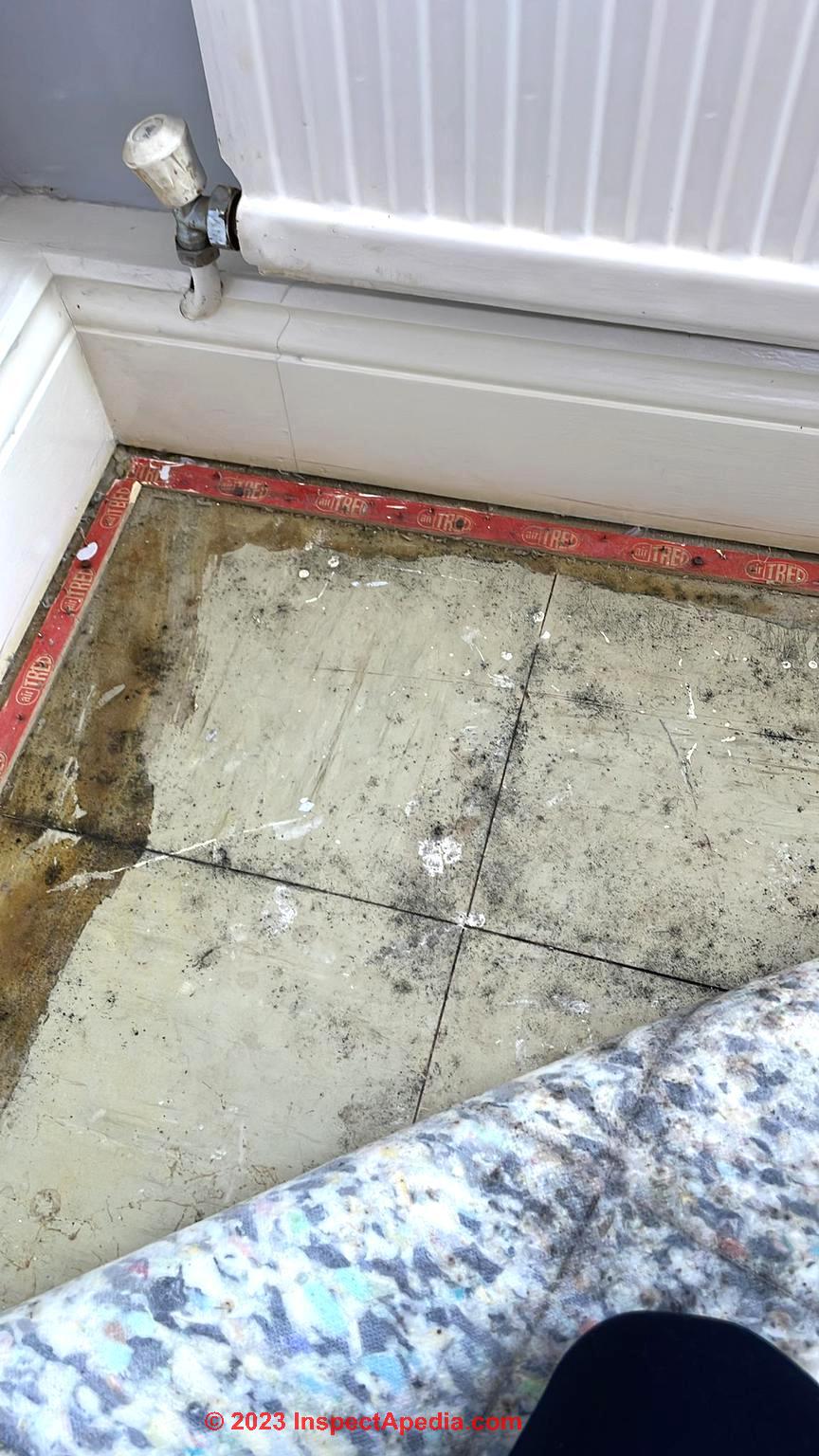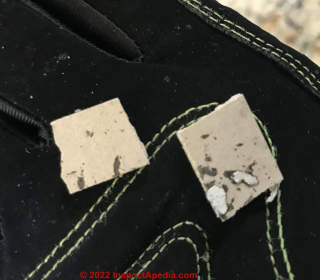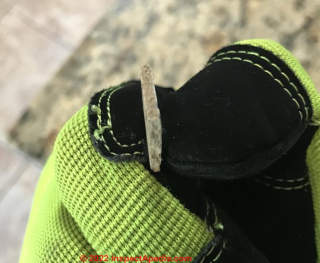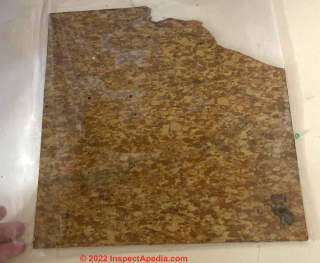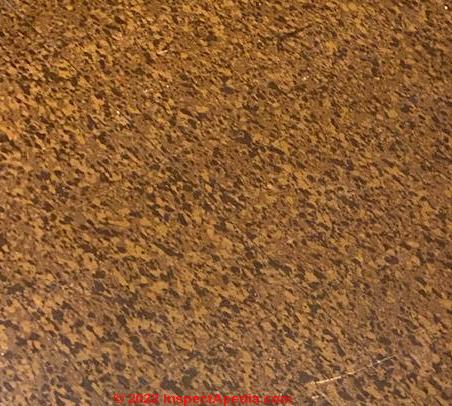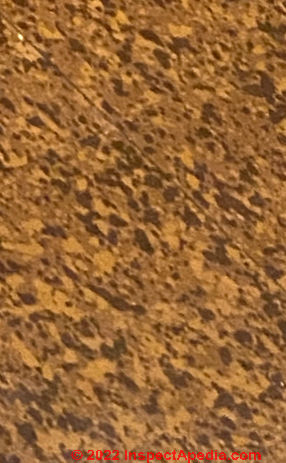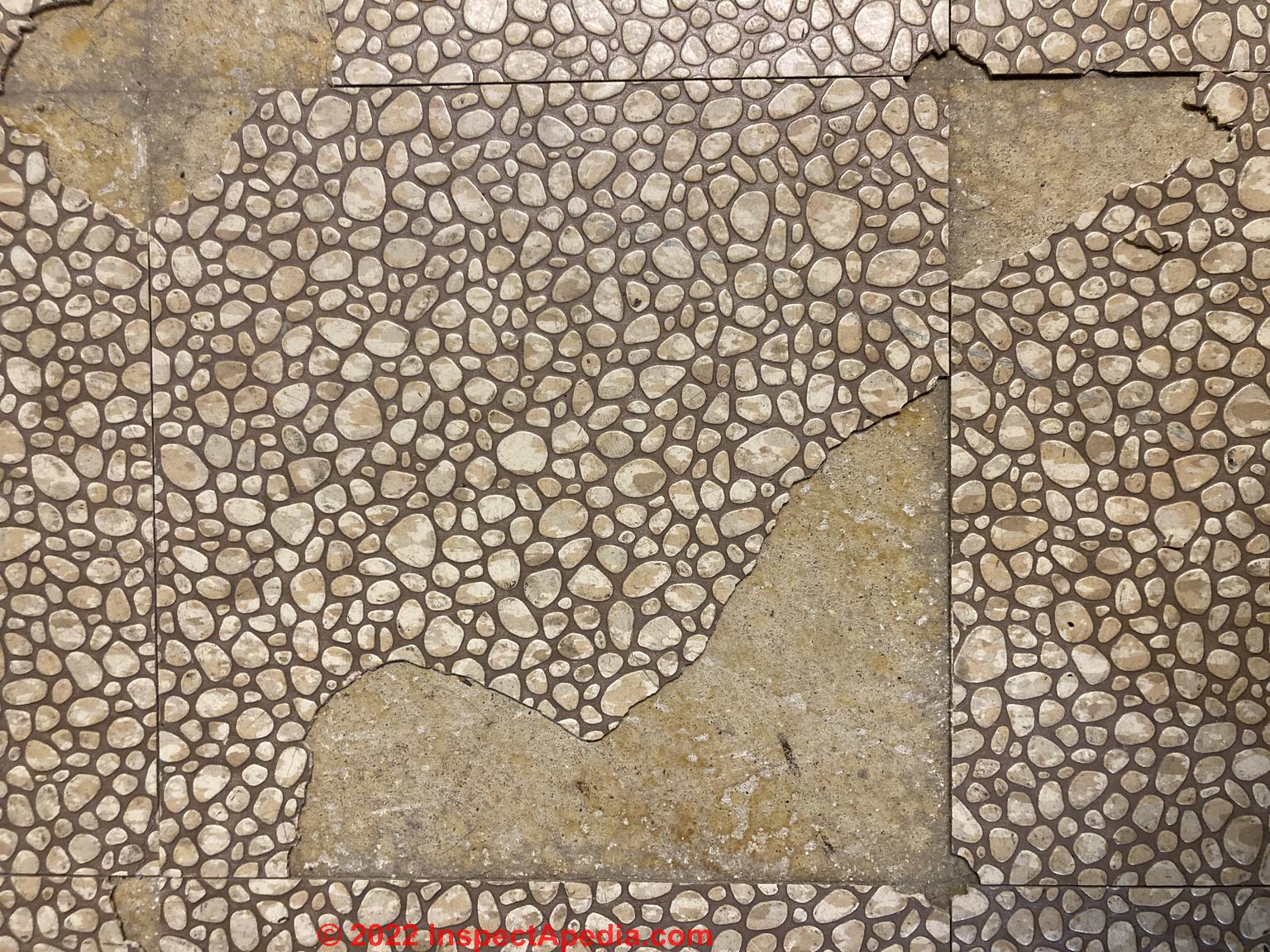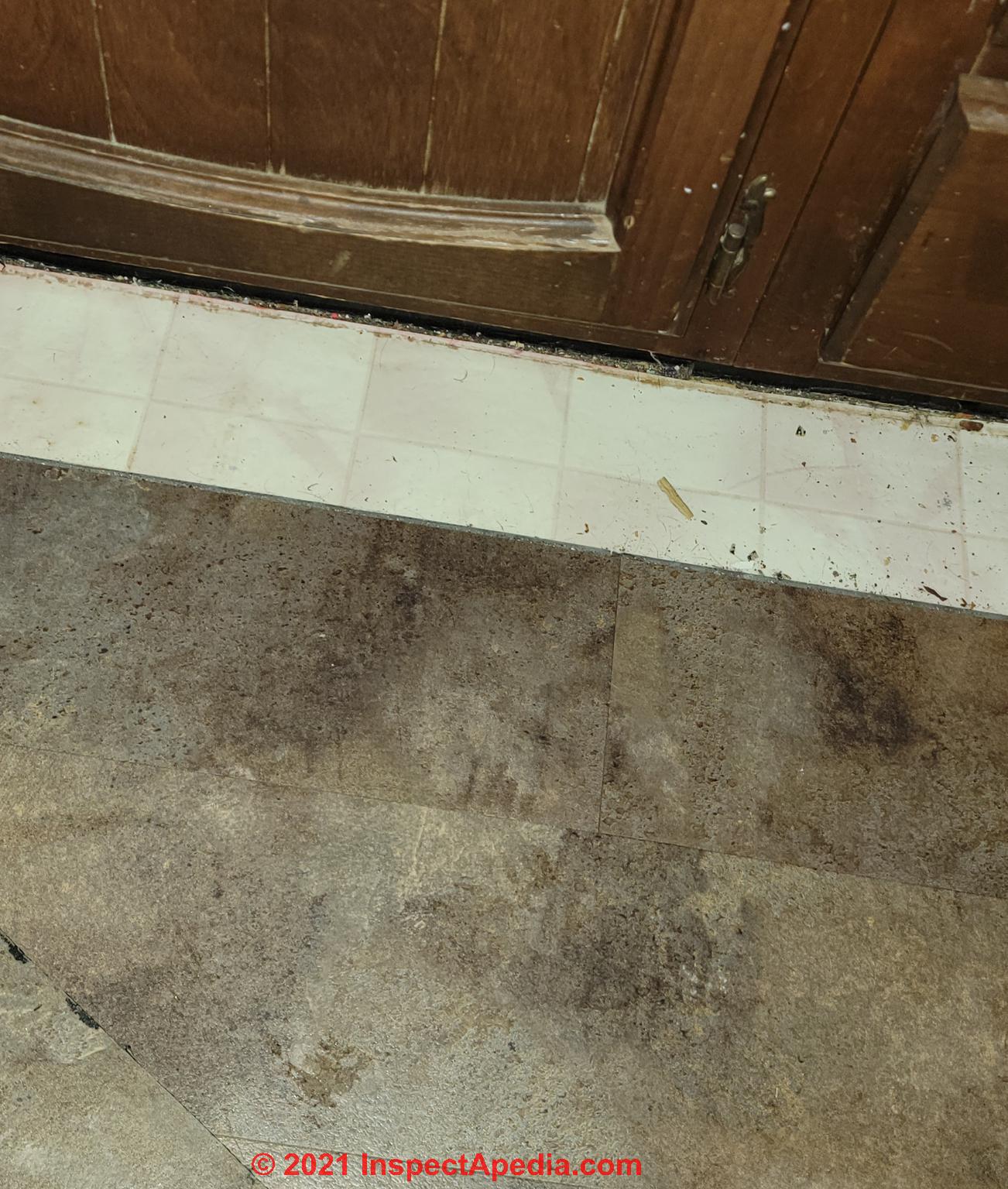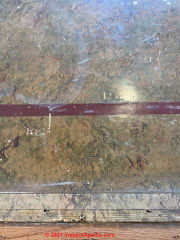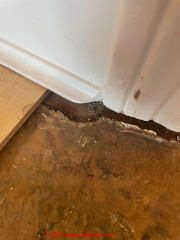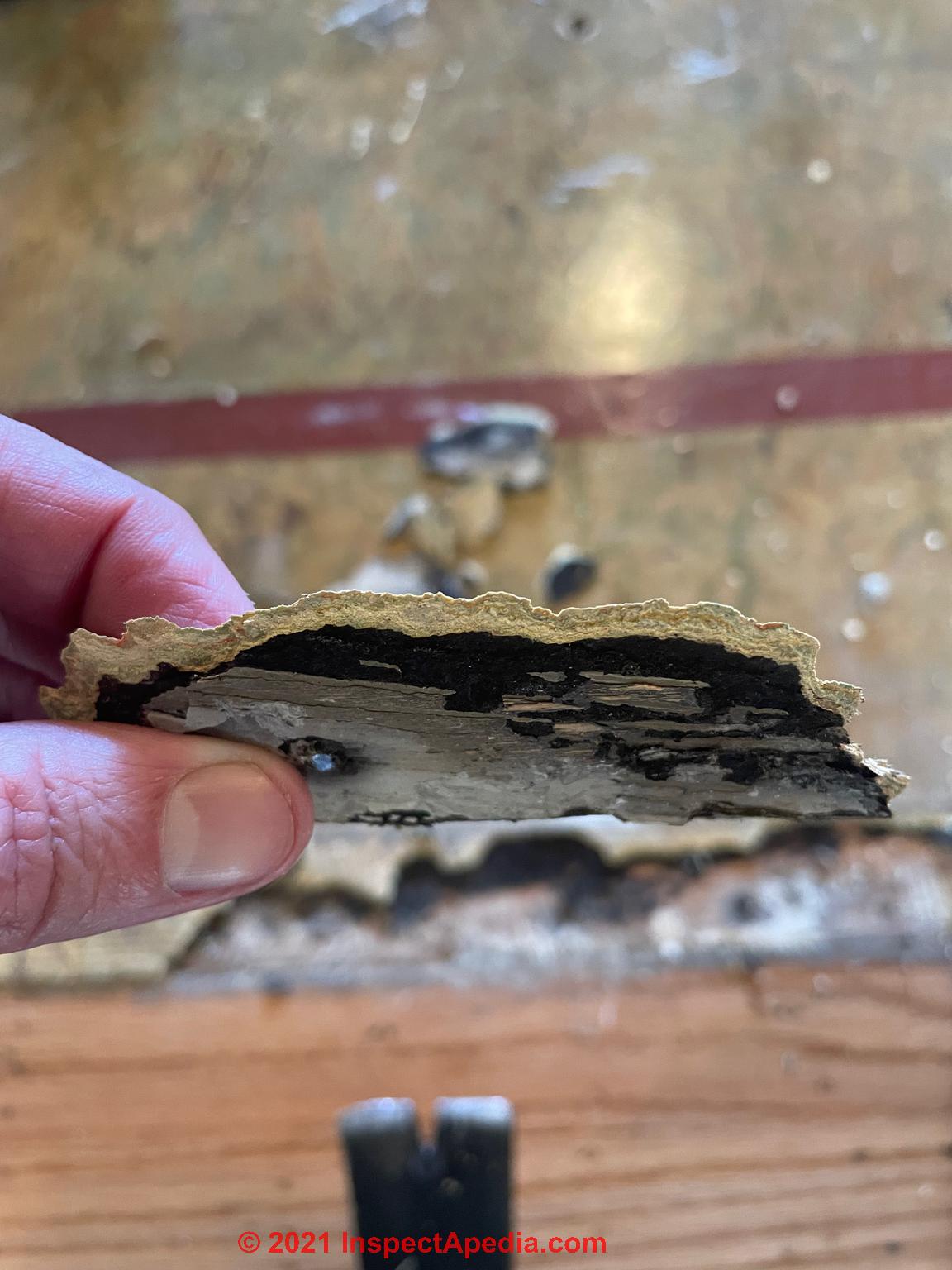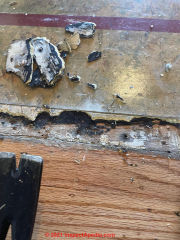 Asphalt Asbestos & Vinyl Asbestos Floor Tiles & Sheet - Identification Photos
Asphalt Asbestos & Vinyl Asbestos Floor Tiles & Sheet - Identification Photos
1900-1959 & Through the 1980's, Armstrong & other flooring manufacturers
Start Here
- POST a QUESTION or COMMENT about how to identify brands & types of vinyl & vinyl-asbestos floor tiles & sheet flooring & about the asbestos content of these products
This page provides a guide to identifying asphalt-asbestos flooring (ca 1920 - ca 1960) & vinyl asbestos floor tile (ca 1952 - 1986): identification photographs, product names, styles, colors, and vinyl-asbestos floor patterns, and colors for asbestos-containing floor tile products made between about 1920 and 1986 - flooring materials that are reported to or have been confirmed to contain asbestos in asbestos fiber or asbestos powder-filler form.
Page top photo: red asphalt-asbestos floor tiles from 1955.
InspectAPedia tolerates no conflicts of interest. We have no relationship with advertisers, products, or services discussed at this website.
- Daniel Friedman, Publisher/Editor/Author - See WHO ARE WE?
Identify Asphalt & Vinyl Asbestos based Floor Coverings & Floor Tiles 1900 - 1986
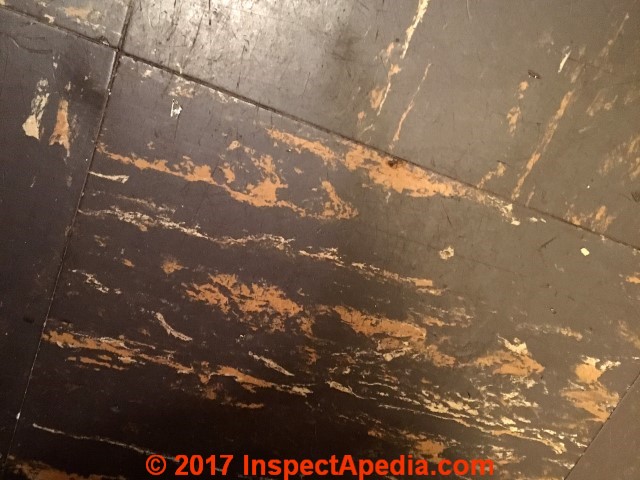
Asphalt-Asbestos resilient floor tiles Manufacturers, Brands, Styles, Photo Guide begins here with a procedure to help determine if your floor covering contains asbestos.
This is the first page in the article series forming a photo guide to asphalt asbestos and vinyl asbestos floor tiles, 1920 -1986.
These flooring products typically contain chrysotile asbestos, and possibly other asbestos forms.
The first publicized asphalt tile installation was in 1920 in New York City's Western Union office.
By 1940, 5% of floor coverings sold in the U.S. were asphalt tile. -- Rosato
Bottom line: Flooring made before 1986 may contain asbestos
For buildings with floor tiles or sheet flooring that can be assumed to have been installed in North America before 1986 it would be prudent to treat the flooring as "PACM" or "Presumed Asbestos Containing Material".
For flooring made in other countries, see the regulation dates and other key dates for last use of asbestos found
at ASBESTOS MATERIAL REGULATIONS
The brown and marble patterned asphalt-based floor tiles shown in our photograph are almost certainly an asphalt-asbestos floor tile from the 1940's or 1950's, probably an Armstrong flooring pattern.
Asphalt-based floor tiles pre-dated vinyl-based floor tiles and were usually of much darker background colors.
Does the floor tile size matter? No.
Asphalt asbestos and vinyl-asbestos floor tiles were produced in 6x6", 9" x 9", 12" x 12", and even 18" x 18" as well as in decorative strips, special cutout shapes, custom dimensions.
Does the floor tile thickness matter? No.
Asphalt asbestos floor tiles were produced in thicknesses of 1/16", 3/32", and 1/8", also in 0.08 gauge.
Do just floor tiles contain asbestos? No. What about sheet flooring or "linoleum"? Maybe.
Some sheet flooring or resilient flooring also contained asbestos, as did floor tile mastics.
Below: Armstrong Linoleum sheet flooring from a 1953 catalog page. Click the image to see the full produc description page.
For a quick check and five easy questions that can help tell you if an unknown floor covering contains asbestos, see
DOES THIS FLOORING CONTAIN ASBESTOS?
Asbestos is safe and legal to remain in homes or public buildings as long as the asbestos materials are in good condition and the asbestos can not be released into the air. - US EPA and other experts
Article Contents
- ASBESTOS FLOOR TILE IDENTIFICATION PROCEDURE
- ASBESTOS-CONTAINING FLOOR TILES 1950s - 1980s COMPARED TO CURRENT VINYL
- SUMMARY OF DATES ASBESTOS WAS LAST USED IN ARMSTRONG® FLOORING
- ARMSTRONG FLOOR TILE CATALOGS 1951 - 1986
- ARMSTRONG FLOOR TILE CATALOG DOWNLOADS [PDFs]
- FLOOR COVERINGS: 1900 - 1949 - separate page
- FLOOR TILE IDENTIFICATION PHOTOS 1951 - 1959
- 1951 FLOOR TILE PHOTOS
- 1952-1953 FLOOR TILE PHOTOS
- 1954 FLOOR TILE PHOTOS & floor tile color changes
- 1955 - 1959 FLOOR TILE PHOTOS & PATTERNS
- FLOOR TILE THICKNESS & USAGE GUIDE
...
Asbestos-containing Floor Tile Identification Procedure
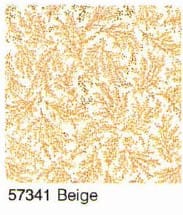
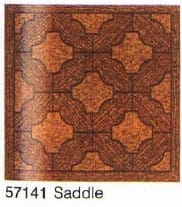
Occasionally we can find extra floor tiles stored in an attic, basement, or garage. An earlier owner or perhaps the floor installer left these for future repairs.
Take a look at the packaging or box (if available) and look for the flooring brand, label, floor tile style or pattern that is often imprinted on the back of both floor tiles and sheet flooring.
Often the manufacturer and product or serial number can identify flooring in exquisite detail.
If you know the brand or manufacturer of your flooring use the brand name link in the list given
at ASBESTOS FLOORING IDENTIFICATION GUIDE INDEX - all brands, all years - index to all the flooring ID guides.
If you do not have this information, as you usually won't,
See DOES THIS FLOOR CONTAIN ASBESTOS? 5 Easy Steps to Decide if a Floor Probably Contains Asbestos
included in ASBESTOS FLOORING IDENTIFICATION our home page for asbestos-containing floor tiles.
If you can identify your floor tile collection name or model number, or if you recognize it in the extensive library of flooring color and pattern photographs provided in these pages, laboratory testing of the sample to screen the flooring for asbestos may be unnecessary.
See ASBESTOS TESTING LAB LIST to choose a certified asbestos testing lab to test a sample from your floor.
We also offer this ASBESTOS FLOOR TILE IDENTIFICATION COLOR KEY - photo guide.
Typical Reader Asbestos Floor Tile Question
Above and below are two examples of two popular asbestos-containing floor tiles from the 1950's sent to us by an InspectApedia reader.
The reader asked:
I recently acquired a house that was built in 1956.
There is some tiling upstairs (red 9"x9" tiles) & downstairs (green 9"x9" tiles), not sure if they were put in when the house was built or later. Would you be able to tell me what kind of tiles these are and if they contain asbestos? - J.M. 9 August 2015
Reply: standard advice for flooring presumed to contain asbestos.
Those look like Armstrong Excelon asbestos-containing flooring from the 1950's - start
at 1950-1959 ARMSTRONG EXCELON FLOOR TILE GUIDE.
Your photos may be a bit color shifted but take a look at very similar Armstrong Excelon tiles in white
(such as SENECA WHITE, OSAGE GREEN and RED shades given in the article below or in the subsequent decade
1960-1969 ARMSTRONG EXCELON FLOOR TILE GUIDE.
ADVICE: For buildings with floor tiles or sheet flooring that can be assumed to have been installed in North America before 1986 it would be prudent to treat the flooring as "PACM" or "Presumed Asbestos Containing Material".
That does not mean we should panic nor undertake an expensive and dangerous asbestos removal project.
Asbestos is safe and legal to remain in homes or public buildings as long as the asbestos materials are in good condition and the asbestos can not be released into the air.
Generally the safest approach is to leave such flooring alone and to cover it over with a coating or with another layer of flooring.
Many of the colors and patterns of asphalt-asbestos or vinyl-asbestos floor tiles were manufactured over many years and may appear in more than one of the floor tile photo collections listed by date range here.
For each year we list the names of the tile patterns sold during that year, we include representative color images of the floor tiles, and throughout the entire floor tile pattern & color history series we include each floor tile color & pattern of the floor tile in the first year that it appeared , and we include representative colors and patterns in other years.
Examples of floor tile packaging, labeling, and other information can be found throughout the flooring photo collections listed here.
...
Older Floor Coverings - 1900 - 1949
Above: a wide board heart pine floor in an 1860's home in "the Bleachery", Wappingers Falls, New York, restored by the author (DF). We removed a layer of carpeting that was installed over a layer of linoleum to expose these boards that were then carefully stripped, cleaned, lightly sanded, and coated with a clear finish.
Older "modern" building floor coverings are traced to the turn of the last century.
In our CORK FLOORING article we trace these through the history of Armstrong Cork and Tile Company.
By 1909 Armstrong had begun producing linoleum. "Corkboard led to fiberboard, fiberboard led to ceiling board, cork floor tile led to linoleum that ultimately led to vinyl floor coverings, in both tile and sheet vinyl forms.
Here are more sources of older floor coverings in popular use before 1949:
- Armstrong Cork & Tile Co., HOW TO LAY & CARE FOR LINOLEUM 1914 [PDF] 2nd Ed., Armstrong Cork & Tile Co, Linoleum Department, Lancaster PA
- Armstrong Cork Products Co., Hazel Dell Brown, The Story of Five Dream Kitchens [PDF] - retrieved 2024/10/26 original source: https://archive.org/details/TheStoryOfFiveDreamKitchens [Copy on file as Armstrrong-5-Dream-Kitchens.pdf ]
- Armstrong Cork Co., Armstrong's QUAKER and SETANDARD RUGS and FLOOR COVERING 1939 [PDF] availble at Building Technology Archive - Internet Archive - [Copy on file as Armstrongs-Quaker-And-Standard-Rugs-And-Floor-Covering-1939.pdf ]
- Armstrong Cork Co., Armstrong Floors and Wall Coverings for Homes and Public Buildings - 1939 [PDF] op. cit., original source: https://ia800502.us.archive.org/18/items/Sweets1939812Cat36/Sweets19398-12%20Cat%2036_text.pdf [copy on file as Armstrong-Catalog-1939.pdf ]
This catalog covers all of the company's flooring products and materials as well as other products such as bulletin boards, wall coverings, and flooring underlayments. - Armstrong Cork Co., Armstrong LINOLEUM PATTERN BOOK 1921 [PDF] - retrieved 2024/10/26, original source: https://ia801708.us.archive.org/19/items/armstrongslinole00arms/armstrongslinole00arms.pdf [Copy on file as Armstrong-Linoleum-Pattern-Book-1921.pdf ]
- Armstrong Cork Co., Armstrong's LINTOILE [PDF] - op. cit. [Copy on file as Armstrong's-Linotile.pdf]
Excerpt: Armstrong’s Linotile® is a beautiful resilient floor that offers ease of maintenance and durability unmatched by any other resilient ffooring material.
Manufactured exclusively by Armstrong since 1914, Linotile is a flooring of proved quality. It is produced essentially from the same raw materials as linoleum, but a series of manufacturing processes make it a completely different flooring with dis- tinctive qualities all its own. - ARMSTRONG SHEET FLOORING 1940 - 1980 [Web Page]
- A. S. Boyle Company, Beautiful floors woodwork and furniture : their finish and care (ca 1925) [PDF] - Internet Archive cited below.
- CORK FLOORING [Web Page]
- FLOOR TILE HISTORY & INGREDIENTS
- FLOORING MATERIALS, AGE, TYPES [Web Page] - all ages and all flooring materials
- LINCRUSTA CEILINGS & WALLS
- LINOLEUM & OTHER SHEET FLOORING [Web Page] - 1900 to present
- TABLE of FLOORING MATERIALS & AGES [Web Page] - all ages and all flooring materials
More older Armstrong flooring products and catalogs can be found at
- Building Technology Archive - Internet Archive - source of many older Armstrong flooring catalogs researched for this article series
...
Armstrong Asphalt Floor Tiles - 1950's to 1980's Compared to Contemporary Vinyl Flooring Products
 Armstrong produced asphalt-based floor tiles, possibly including asbestos in their formulation, before 1952 and in later years as we indicate with examples and photographs in the detailed photo guide that is found below.
Armstrong produced asphalt-based floor tiles, possibly including asbestos in their formulation, before 1952 and in later years as we indicate with examples and photographs in the detailed photo guide that is found below.
For more information about these older flooring types,
see ASPHALT & VINYL FLOOR TILE HISTORY - history, dates, and description of the production process and ingredients in asphalt floor tiles, asphalt-asbestos floor tiles, & vinyl-asbestos floor tiles 1900 to present. Kentile flooring produced through 1986 may contain asbestos.
Also don't assume that only "vinyl asbestos floor tiles" include asbestos.
According to Rosato [REFERENCES], asbestos filler (powder) and fibers were used in asphalt based products too.
"The first publicized installation of asphalt tile was in the Western Union office in New York City (1920). By the end of 1930, 3 million square yards of tile was being produced annually.
Below in this document we provide detailed year-by-year photos of Armstrong asphalt or vinyl-asbestos flooring products from 1952 to 1982. Records show that many but not all flooring products produced during these years, including 9" floor tiles, 12" floor tiles, peel-and-stick floor tiles, and sheet flooring indeed contain asbestos.
Later Armstrong flooring products, for example Armstrong's
ACCOFLEX 2005 series semi-flexible vinyl tile [PDF] sold (at least) in the U.K. were produced from " ground limestone bound with polymers, plasticizers, and stabilizers, and colored by pigments" not including asbestos.
At FLOOR, RESILIENT VINYL or CORK we discuss the choices, selection and installation details for contemporary vinyl and other resilient flooring products.
...
Summary of Dates Asbestos was Last Used in Armstrong® Flooring
Last-Use Dates for Asbestos in Armstrong Floor Products Manufactured in the U.S. |
|
| Flooring Type | Last Asbestos Use in Flooring Manufacture |
| Armstrong Commercial floor tile | June 1981 |
| Armstrong Residential floor tile | December 1982 |
Armstrong Flooring Adhesives S89 / S90 |
January 1983 |
| Armstrong Sheet flooring - vinyl | April 1983 |
Note that these tables and dates of last asbestos use pertain only to Armstrong flooring products made in the U.S. (above) or Canada (below)
Last-Use Dates for Asbestos in Armstrong Floor Products Manufactured in Canada |
|
| Flooring Type | Last Asbestos Use in Flooring Manufacture |
| Armstrong Sheet flooring - vinyl | 1984 |
| Armstrong Commercial floor tile | 1985 |
| Armstrong Residential floor tile | 1985 |
See also
- U.S. EPA, DATES of U.S. FEDERAL BANS on USE of ASBESTOS, U.S. Environmental Protection Agency
...
Armstrong Vinyl-Asbestos Floor Tile Photo ID Catalogs - 1951 - 1986
Our reproduction of vinyl-asbestos floor tile patterns and colors below selected representative images of each style or floor tile identification pattern in which tiles were produced.
Within each pattern there were various colors available as well. By minimizing repetition of patterns and colors, across the set of years we show at least one example of nearly every pattern and color produced for these floor tiles.
Our photo (left) from Rosato (cited atReferences or Citations ), shows an Armstrong asphalt floor tile installation.
On occasion, the original flooring packaging or installation literature may be available for a given home: often an extra box of floor tiles was kept for future repairs.
The vinyl-asbestos floor tile package label information, combined with a simple comparison of tiles in the package with tiles installed in the building may be sound confirmation of asbestos-containing materials.
See VINYL ASBESTOS FLOOR TILE PACKAGING.
Historical information about the dates of flooring installation may also be sufficient to rule in or out the possibility that flooring in a building contains asbestos.
Where the same floor style pattern was produced for multiple years, in subsequent years we show other colors in which the tile pattern was made. Just scroll through this vinyl asbestos floor tile photo guide to find the first occurrence of each floor tile style, pattern, name, dimensions, and colors.
Or if you know the approximate year that your floor was installed you can scroll down to that very year in our photo library.
It is instructive to take a close look at our tile photos from 1973 and 1974. Some floor tile colors and patterns, especially among the "standard" tiles, include both asphalt-based tiles and vinyl-asbestos tiles that look quite alike. But the combination of color, pattern, and size can help distinguish among these.
For example, "Standard Pattern" floor tiles were produced in both vinyl-asbestos form and in an asphalt tile without asbestos in 1973.
But asphalt-based tiles that did not contain asbestos were produced in 1973 only in 9"x9".
So flooring made for that year and particular pattern, the tile size provides important information.
Watch out: Because flooring products may have been produced in years earlier than the year of installation, don't assume that a floor installed in a building built shortly after 1980 could not possibly contain vinyl-asbestos product.
As we warned just above, don't assume that only "vinyl asbestos floor tiles" include asbestos.
...
Online Armstrong Floor Catalog Downloads - 1950s, Tile & Sheet Flooring
 Shown: Armstrong Cork Embossed Inlaid Linoleum Pattern 5610, ca 1955 [Click to enlarge any image]
Shown: Armstrong Cork Embossed Inlaid Linoleum Pattern 5610, ca 1955 [Click to enlarge any image]
- ARMSTRONG EXCELON FLOOR TILE CATALOG, ca 1951 [PDF]
- COLOR CHOICE for 1954, ARMSTRONG'S ASPHALT TILE CATALOG [PDF] retrieved 2018/02/07, original source: digitized by APTI, https://ia800409.us.archive.org/28/items/ArmstongsAshpaltTile1954/Armstrong%27s%20Ashpalt%20Tile%201954.PDF
- ARMSTRONG TERAZZO CORLON 1955, [PDF] Armstrong Cork Co. [Copy on file as Armstrong-Terrazzo-Corlon-1955.pdf ] as distributed by the Piersol Col, Inc., 24 East King St. Lancaster PA, Phone 9280. - This Armstrong sheet flooring product in popular patterns is llustrated below

- HOW TO INSTALL ARMSTRONG ASPHALT TILE [PDF] digitized by APTI as cited in this document, retrieved 2018/02/07, original source: https://ia801209.us.archive.org/19/items/HowToInstallArmstrongAsphaltTile/How%20To%20Install%20Armstrong%20Asphalt%20Tile.PDF
- ARMSTRONG 1955 ASPHALT FLOOR TILE CATALOG [PDF]
- ARMSTRONG LINOLEUM LINOWALL CATALOG [PDF] Armstrong Cork Company, Lancaster PA, retrieved 2018/02/07 describes Armstrong's linoleum, linowall, and asphalt tile flooring.
The Armstrong Cork Co. building products listed by this catalog include:
Armstrong floors: Linoleum, Linoflor, Mastic Armoflor, Quaker Rugs, Quaker Floor Covering, Standard Rugs
Armstrong standard floor coverings: Asphalt tile, Linotile (Oil-Bonded), Rubber tile, Monocork, Cork tile, Cork Carpet
Armstrong wall finishes: Linowall, Monowall, Cork Tile, Temlok De Luxe Interior Finish, Temwood, Blocked Temwood, Temboard, Temboard De Luxe
Armstrong insulation: Corkboard, Temseal Insulating Sheathing, Temlok Insulating lath.
...
Armstrong Floor Tile Photo Identification Guide 1950 - 1959
Asphalt-Asbestos / Vinyl Asbestos Flooring
Armstrong Accoflex, [Estimated 1950's] - Contain Asbestos?
Above is an excerpt from a 1950's era Armstrong Accoflex "easy-lay" floor tiles advertising poster. These tiles may contain asbestos. [Research in process].
1951 Armstrong Asphalt Asbestos Floor Tiles Patterns & Color Guide, 9"x9"x1/8"
According to Armstrong vinyl-asbestos floor tiles such as those shown here were produced by the company from 1951 through 1973.
These examples illustrate two shades of Palimino Beige 9"x9"x1/8"-thick asphalt-asbestos tile (AAT) whose asbestos content has been confirmed by asbestos test lab results generously provided along with these photographs by reader L.R. (October 2012).[25]
Our own field work has found that this tile pattern, in a range of colors illustrated below, was enormously popular and can still be found installed in thousands of homes built between 1951 and the early 1970's.
The most common colors we have found include the beige shades shown below along with green, white, black, and Apache red illustrated further below.
The Armstrong Pecan Beige asphalt asbestos floor tile illustrated at above left (pattern C-913) has been confirmed by independent testing to contain about 10% asbestos while the Armstrong Palimino Beige asphalt floor tile (above right, pattern C-926) was confirmed at 6.4% asbestos.
Our photo, courtesy of reader L.N. illustrates the original packaging used for Armstrong asphalt floor tiles - Armstrong Asphalt Floor Tile, produced by Armstrong’s Cork division.
The tile pattern identified as C-926 Palimono Beige corresponds to the tile photograph at above right, a 1/8" gauge asphalt asbestos floor tile.
These tiles are mostly asphalt with the percentages of asbestos given above, as tested by the reader's asbestos lab. Armstrong has indicated that that these tiles almost certainly contained asbestos but they said that as long as the tiles are not ground or sanded there should not be a detectable asbestos hazard in residential use.
See ASBESTOS FLOORING HAZARD REDUCTION for recommendations useful for leaving this flooring in place, or
see ASBESTOS REMOVAL, WETTING GUIDELINES if your asbestos-suspect or presumed-asbestos-containing flooring is in very poor condition or has to be removed.
1952 - 1953 - Armstrong Excelon Plastic Asbestos Floor Tiles, Patterns & Color Guide
Definition & Composition of Asphalt based asbestos resilient floor tiles
Asphalt asbestos floor tiles (AAT) refers to resilient flooring that was asphalt based. While thicknesses vary, most often if the floor tiles are 1/8" thick and are of this vintage you will find that they have an asphalt and asbestos base.
Definition & Composition of Vinyl based asbestos resilient floor tiles
Vinyl asbestos floor tiles (VAT) refers to resilient flooring whose basic binding material was a vinyl plastic, replacing asphalt as the primary ingredient.
The 1954 catalog refers to the existence of at least a 1952 version of this vinyl-asbestos resilient floor tile product:
"Federal Specifications - Interim Federal Specifications No. L T 751 (GSA-FSS) dated March 18, 1952, defines Armstrong's Excelon Tile and other similar plastic asbestos tiles as Type I Semi Flexible Vinyl Plastic Floor Tile.
...
... the thermoplastic binder of a vinyl plastic floor tile shall consist of only a limited group of certain specific types of polyvinyl chloride resins despite the fact that a wide range of vinyl resins could be used.
...
... note that while Excelon Tile does not the exact material composition of Interim Specifications No. L T 751, it does meet all the physical tests listed."
1954 - Armstrong Excelon Plastic Asbestos Floor Tiles, Patterns & Color Guide
One pattern of softly merged colors that Armstrong described as "swirl graining" in 10 colors, these 1954 floor tiles were sold only in 9" x 9" 1/8" gauge
1954 Floor Tile Color List:
CHALK WHITE 750, shown above, from a 1954 Armstrong floor tile catalog.
SLATE GRAY 751, shown above, from 1954
CHARCOAL BLACK 752, also from 1954.
GYPSY RED 753, [click to see]
GRETNA GREEN 754,
FORMOSA CORAL 755 above, from 1954
Manila Tan 756,
SIROCCO TAUPE 757,
BRITTANY BLUE 758,
MING YELLOW 759
and more from 1954
Library of vinyl asbestos floor tile and flooring strip images from 1954 - 1980, Armstrong and others.
Armstrong 1954 Asphalt Asbestos Floor Tile Catalogs
- COLOR CHOICE for 1954, ARMSTRONG'S ASPHALT TILE CATALOG [PDF] retrieved 2018/02/07, original source: digitized by APTI, https://ia800409.us.archive.org/28/items/ArmstongsAshpaltTile1954/Armstrong%27s%20Ashpalt%20Tile%201954.PDF
- HOW TO INSTALL ARMSTRONG ASPHALT TILE [PDF] digitized by APTI as cited in this document, retrieved 2018/02/07, original source: https://ia801209.us.archive.org/19/items/HowToInstallArmstrongAsphaltTile/How%20To%20Install%20Armstrong%20Asphalt%20Tile.PDF
1955 - Complete Armstrong Excelon Vinyl Plastic Asbestos Floor Tiles, Patterns & Color Guide
See the complete 1955 Armstrong flooring identification key and catalog
at ASBESTOS FLOOR TILE IDENTIFICATION PHOTOS 1900 -1950s
Above: 1955 asphalt asbestos flooring: Armstrong Excelon
and FOAM GREEN C-092 are shown combined in this excerpt from the Armstrong Cork catalogs shown below.
1956 - Armstrong Excelon Vinyl Plastic Asbestos 9 x 9 Floor Floor Tiles, Patterns & Color Guide
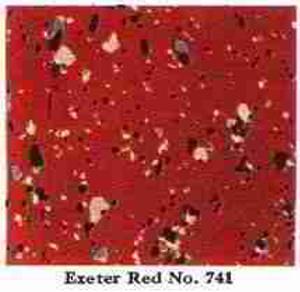
For space and speed we moved this data.
See our complete 1956 Armstrong flooring identification keys at ASBESTOS FLOOR TILE IDENTIFICATION PHOTOS 1956-1957
1957 - Armstrong Excelon Vinyl Asbestos Floor Floor Tiles, Patterns & Color Guide
For space and speed we moved this data to our 1957 Armstrong flooring identification keys
at ASBESTOS FLOOR TILE IDENTIFICATION PHOTOS 1956-1957
1958 - Armstrong Excelon Vinyl Asbestos Floor Floor Tiles, Patterns & Color Guide
For space and speed we moved this information
to ASBESTOS FLOOR TILE IDENTIFICATION PHOTOS 1958-1959
1959 - Armstrong Excelon Floor Vinyl Plastic Asbestos Floor Tiles, 9" x 9"
For speed and space we also moved this key
to ASBESTOS FLOOR TILE IDENTIFICATION PHOTOS 1958-1959
Asphalt or Vinyl Asbestos Floor Tiles Color Guide
Armstrong and other floor tile or sheet flooring manufacturers often offered several patterns with a particular dominant color that can help quickly identify the flooring brand and style.
We include some examples
at ASBESTOS FLOOR TILE IDENTIFICATION COLOR KEY - separate article.
...
Key to Thicknesses or Gauges of Vinyl-Asbestos Floor Tiles & Floor Tile Application or Usage by Thickness
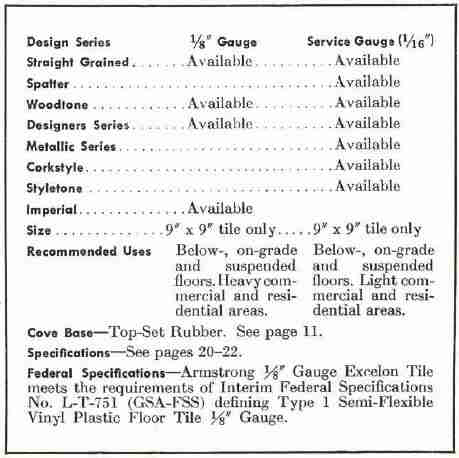
Vinyl Asbestos Floor Tile Thickness & Usage Guide
Shown above is a vinyl-asbestos floor specification summary and usage guide from a 1959 - Armstrong floor tile catalog.
...
Reader Comments, Questions & Answers About The Article Above
Below you will find questions and answers previously posted on this page at its page bottom reader comment box.
Reader Q&A - also see RECOMMENDED ARTICLES & FAQs
1993, grey diamond pattern vinyl floor tiles in a Toronto home: removed by heating with an iron
Toronto, 1993, grey diamond pattern vinyl tiles. I heated them with an iron, then peeled them off about a 200 foot square area because there was hardwood underneath.
It took about 2 days. They weren't particularly damaged or cracked as far as I can remember, I just hated the way they looked. I was 23 and yes super duper dumb. This is the only photo I have.
I haven't found any patterns similar, so hope I've dodged an asbestos bullet. I seem to recall most of the tiles peeled off quite easily, but some of them broke.
There wasn't too much glue underneath, I don't think I sanded the hardwood afterwards. It was an apartment. - On 2023-06-05 by Jill - Toronto,
Reply by InspectApedia DF (mod)
@Jill,
If they were installed in 1993, that is past the year when asbestos was discontinued in flooring.Followup by Jill
@InspectApedia DF, Thanks for the reply... I ripped them out in 1993. They could have been there 10 years!
Reply by InspectApedia DF (mod) - too late to worry about removal of flooring in 1993
@Jill,
Got it. So we don't know exactly what they were this much later and it's impossible to tell from just one photo since some popular asbestos patterns were continued without asbestos after the cutoff date.The fact that they didn't break or crack much or create a bunch of dust is good, reducing the potential risk if they did contain asbestos.
If you still lived there and were concerned, I would suggest damp wiping and a HEPA vacuum but obviously that's a moot point now.
Advice about this Armstrong sheet flooring from a 1979 house? M© Armstrong # 0559960109
House built 1979. Thoughts?
On 2023-05-03 by Dylan -
Reply by InspectApedia Editor - treat that flooring as PACM
@Dylan,
Best to treat that floor as "PACM" - Presumed Asbestos Containing MaterialAt Recommended Articles on this page, see the live links for
DOES THIS FLOOR CONTAIN ASBESTOS? - 5 easy questions to tell if your FLOOR probably contains asbestos -
and ASBESTOS FLOORING HAZARD REDUCTION - usually best to leave such flooring in place and cover it over.
1978 Toronto Ontario house basement 12x12 floor tiles: should we test for asbestos?
My father in law moved in to the house on 1978 (Toronto, ON). Basement was finished probably in the 70s. Attached photo shows pattern of the vinyl tile (12”x12”). There is some black adhesive on concrete.
We’re are not renovating but want to sell house as is. Is it worth it to have it tested for asbestos since we will be moving old stuff from basement. Need option of possible. - On 2022-12-04 by Warren -
Reply by InspectApedia (Editor) - if the floor is well secured and in good condition there's no reason that it should be removed
@Warren,
If the floor is well secured and in good condition there's no reason that it should be removed. The most that a new buyer would do would be perhaps to seal it or cover it over with new material.It's important to understand that asbestos is safe and legal in homes if it's in good condition.
Before spending money on what's probably an unnecessary course of action you might save your money to see what matters to your future buyer.
Is this 1972 Vancouver Special home sheet flooring an asbestos product?
Just discovered this sheet flooring under the hardwood in our 1972 Vancouver Special.
Is this a familiar pattern known to have asbestos? - On 2022-11-27 by Guy -
Reply by InspectApedia (Editor) - 1972 Vancouver Special sheet flooring may have asbestos
@Guy,
We don't know for a fact, but 1970's sheet flooring like that often used asbestos in the white-ish backer.That flooring is in poor condition, so could become an asbestos hazard; you'll want to treat it as if it contains asbestos or have a sample tested. .
Is this an asbestos floor tile? - Gray, Tan, Beige Fleck or "Cork pattern" floor tile asbestos.
Would this be asbestos tile?
On 2022-11-05 by Diana -
Reply by InspectApedia (Editor)
@Diana,
From appearance alone, most likely yes, you didn't give any information about the location country City or age of the building but if your floor is in North America and is of the Vintage site on this page you would treat it as presume to contain asbestos
I'm freaking out that this flooring in my 1940 house contains asbestos
Do you think this has asbestos? Please email me at aprilelder at Hotmail dot com.
house was built in 1940. was renovated a few times but I just pulled up carpet and found this flooring
please help. im actually freaking out lol - On 2022-10-18 by April -
Reply by InspectApedia (Editor) - Asbestos flooring is perfectly safe if undamaged
@April,
Yes. Perfectly safe if undamaged. Leave the flooring alone & cover it with a layer of new flooring.
See
ASBESTOS FLOORING HAZARD REDUCTION
inspectapedia.com/hazmat/Asbestos-Flooring-Hazard-Reduction.php
Early 1980s house flooring: is this asbestos?
Hi myself and my partner, have just bought a house built between 1983-1985.
We are hoping to get new wooden flooring across the whole downstairs.
They have laid carpet above the tiles (in the attached photo) and also laid stone tile & concrete on top of this in the kitchen. Is this asbestos tiling? On 2022-08-26 by Lanca006 -
Reply by InspectApedia-911 (mod) - treat 1980s floor as presumed to contain asbestos
@Lanca006,
Quite possibly if your home is in the U.S. and probalbly in most other countries too.It would be prudent to treat that floor as presumed to contain asbestos. Only if demolition is required would it be really useful to have a sample tested for asbestos.
At Recommended Articles see the live links for
DOES THIS FLOOR CONTAIN ASBESTOS? - 5 easy questions to tell if your FLOOR probably contains asbestos -
and ASBESTOS FLOORING HAZARD REDUCTION - usually best to leave such flooring in place and cover it over.
Evaluate the asbestos hazard in flaky 9-inch tiles in a 1968 home
About 1/8”. Appears design is embossed.
9” tiles approx. house built 1968 these in the basement.
Flaky. I am assuming these to be linoleum but unsure. Glued down with a black glue. Cannot tell if there is jute backing.
On 2022-07-24 by Pete
Reply by InspectApedia-911 (mod) - 1968 floor tiles are presumed to contain asbestos
@Pete,
9" floor tiles would not normally be "linoleum". Linoleum is a sheet flooring. Your photo looks like floor tiles to me.
Treat those floor tiles as presumed to contain asbestos, or have a sample tested.But to be technically complete, some installers cut or installed cut shapes and pieces of linoleum or other sheet flooring in some designs.
Pleae see details at LINOLEUM & OTHER SHEET FLOORING to understand the difference between a floor tile and sheet flooring.
Followup by Pete - did linoleum "come only in sheets"
@InspectApedia-911, thanks, so old linoleum only came in sheets? I am going to cover these with Marmoleum.
Reply by (mod) - No, Linoleum could be cut into squares; Examples of Marmoleum flooring
In general, as I said, linoleum was manufactured, sold, installed as a sheet product.
But it is absolutely the case that that product was also at times cut into squares, shapes, or patterns for installation in special floor designs.
Please, as I suggested, read the LINOLEUM & OTHER SHEET FLOORING article that I recommended, as it will provide more complete and interesting reply than I can type over again de-novo here.
For other readers: above and below we show an example of Marmoleum Cinch Loc Seal 11.81” x 11.81” x 9.9mm Laminate Flooring By Forbo, sold at building suppliers and online vendors.
9x9 cork pattern floor tiles, some removed, leaving black mastic adhesive: are we in danger
Damaged flooring in our downstairs from previous owner sloppy removal my guess is they never had it tested. The entire floor down here shows 9x9 black glue square left overs that they covered with carpet. Behind the washer and dryer is where there’s damaged existing tile sporadic there.
Say these are in fact asbestos we have just been living in a home with them damaged and glue chillin under pad and carpet. How exposed are we? - On 2022-05-17 by Demi -
Reply by InspectApedia (mod) - no need to panic, but it's best to cover over or seal asbestos-suspect flooring
@Demi,
The best thing is to simply leave the suspect tile in place and cover with new flooring. Unless it’s being ground, sawed, or broken up, causing dust, it is nonfriable and not posing a risk.
Since we don’t know the age of your tile or home, you can make a reasonable guess as to its asbestos content or not by answering the 5 easy questions here:
DOES THIS FLOORING CONTAIN ASBESTOS? - 5 easy steps that can help you make a reasonable guess at whether or not the floor you ask about contains asbestos.
https://inspectapedia.com/hazmat/DIY-Asbestos-Floor-Test.php
If the floor must be removed then see the asbestos floor removal and asbestos hazard reduction articles found in the ARTICLE INDEX at the end of any of these pages.
Can I buy more of this brown and orange speckled flooring? (Cork Pattern)
Question: I'd like to identify this and see if these are still sold in this exact pattern and color.
It was installed in the 1960's in New York City. I blew up the shot so you could see the details. But it's like a brownish red with specks.
The specks have like orange and darker brown in them.
On 2022-03-20 by dawn r. (nyc) -
Reply by Inspectapedia Com Moderator - Yes - cork style vinyl or vinyl asbestos floor pattern
@dawn r. (nyc),
That looks like a cork style vinyl or vinyl asbestos floor pattern.Currently (2022, updated as of 2024) there are a number of companies, including Armstrong (who probably made your floor tile) making and selling cork pattern finyl floor tiles, though it may be difficult to find an exact match for what you've already got installed.
Other examples of vinyl floor tiles in a cork pattern include Eco Forest, Globus Cork, Nugget Texture, Perfection Floor Tiles, and Tarkett flooring. Examples are shown below.
1961 Embossed Pebblette Armstrong flooring - are these floor tiles "safe" ?
I noticed these two types of tiles in my basement house built 1961 the brownish cream ones are very thin and began to crack in some areas and the grey ones are also quite thin but intact. not sure if these are asbestos or safe.
Thank you kindly and this is the second image where they are cracked and peeling. - On 2022-02-06 by your opinion is much appreciated 2 -
Reply by Inspectapedia Com Moderator -
@your opinion is much appreciated 2,
The 'pebble' pattern tile may be Embossed Pebblette as identified here
1960S ARMSTRONG FLOORING
Your other gray tile is similar to many patterns from different companies.
It would be best to treat the tile as presumed to contain asbestos, keeping in mind that the safest and least costly approach is to leave the flooring alone, in place, and to cover it with new material.
Have a sample of the flooring tested, or you can make a reasonable *guess* at whether or not the floor contains asbestos by answering the few easy questions found at:
DOES THIS FLOORING CONTAIN ASBESTOS? - 5 easy steps that can help you make a reasonable guess at whether or not the floor you ask about contains asbestos.
https://inspectapedia.com/hazmat/DIY-Asbestos-Floor-Test.php
Asbestos is safe and legal to remain in homes or public buildings as long as the asbestos materials are in good condition and the asbestos can not be released into the air. - US EPASee our advice
On 2022-01-18 by Eva - Is this top layer of linoleum likely to contain asbestos in my 1952 house?
I'm buying a house from 1952. I intend to remove the top layer of linoleum from the kitchen floor (brown rectangular tiles in photo). Is it likely to contain asbestos?
On 2022-01-10 by Chris -
Reply by Inspectapedia Com Moderator
@Eva,
Even though the house was built in 1952, the flooring in your photo seems to have been installed over an earlier flooring. Depending on when the flooring in question was installed, it would be safe to presume it contains asbestos.
That flooring might contain asbestos if it was installed in a building in North America before 1987. From a photo one can’t answer your question with certainty. Popular flooring patterns were continued, without asbestos, after 1986.
Have a sample of the flooring tested, or you can make a reasonable *guess* at whether or not the floor contains asbestos by answering the few easy questions found at:
DOES THIS FLOORING CONTAIN ASBESTOS? - 5 easy steps that can help you make a reasonable guess at whether or not the floor you ask about contains asbestos.
https://inspectapedia.com/hazmat/DIY-Asbestos-Floor-Test.php
Asbestos is safe and legal to remain in homes or public buildings as long as the asbestos materials are in good condition and the asbestos can not be released into the air. - US EPA
The safest and least costly approach is to leave the flooring alone, in place, and to cover it with new material.
If the floor is in poor condition or must be removed then see the asbestos floor removal and asbestos hazard reduction articles found in the ARTICLE INDEX at the end of any of these pages.
Is there asbestos in this linoleum found in my 1949 house?
Hi, This was under the fake wood floor planks in my kitchen. The home was built in 1949. Is this likely asbestos? Thanks.
-On 2022-01-10 by Chris -
Reply by Inspectapedia Com Moderator
@Christian Morgan,
That looks like old sheet flooring or "linoleum" not a tile floor. Am I right?
If so see
RESILIENT SHEET FLOORING ID GUIDEThe backer may contain asbestos -don't create a dusty mess and you'll be ok.
Followup by Christian Morgan
@Danjoefriedman, Thank you.
Here are a few more photos of it. It's only a few millimeters thick with a black paper-like back surface.
Reply by Inspectapedia Com Moderator
@Christian Morgan,
That black backer may be asphalt-impregnated paper or "felt" - sometimes that contains asbestos.
See LINOLEUM & SHEET FLOORING
and also
see LINOLEUM ASBESTOS CONTENT?
Thank you to our readers for their generous comments
Noted. Thank you for your kind attention to my query. - On 2023-06-05 by Jill - @InspectApedia DF,
This site is so helpful, thank you everyone! -< On 2019-11-14 by Erin -
I have identified another sheet vinyl (Armstrong splatter pattern) used in the house using your resources (Thanks!) - On 2021-03-14 by Rory -
Reply by InspectApedia DF (mod)
@Jill, @Erin:
Glad to help. We've worked on this material for decades so are always grateful when a reader finds it useful and trustworthy.
We welcome any additional questions, comments, or suggestions.
...
Continue reading at ASBESTOS FLOOR TILE IDENTIFICATION PHOTOS 1900 -1950s or select a topic from the closely-related articles below, or see the complete ARTICLE INDEX.
Or see ASBESTOS FLOOR TILE IDENTIFICATION 1949-1959 FAQs - questions & answers about identifying asbestos-containing floor tiles in floors made in the 1950s, posted originally at this page
Or see these
Recommended Articles
- ARMSTRONG FLOOR TILE IDENTIFICATION - home - you are on this page
- ARMSTRONG ACCOFLEX FLOORING & TILES 1989 & LATER
- ARMSTRONG CORLON FLOORING - Corlon® vinyl flooring & in CorAire, Hydrocord® & Nylex
- ARMSTRONG CORLON MARBLE / STONE CHIP PATTERN ASBESTOS
- ARMSTRONG FLOOR COVERINGS: 1900 - 1949
- ARMSTRONG FLOOR TILE IDENTIFICATION PHOTOS 1951-1954 - Excelon & Others
- ARMSTRONG FLOOR TILE IDENTIFICATION PHOTOS 1955
- ARMSTRONG FLOOR TILE IDENTIFICATION PHOTOS 1956-1957
- ARMSTRONG FLOOR TILE IDENTIFICATION PHOTOS 1958-1959
- ARMSTRONG FLOOR IDENTIFICATION PHOTOS 1960-1969
- ARMSTRONG FLOOR TILE IDENTIFICATION PHOTOS 1970-1972
- ARMSTRONG FLOOR TILE IDENTIFICATION PHOTOS 1973, COMPLETE GUIDE
- ARMSTRONG FLOOR TILE IDENTIFICATION PHOTOS 1974 - 1979
- ARMSTRONG FLOOR TILE IDENTIFICATION PHOTOS 1979
- ARMSTRONG FLOOR TILE IDENTIFICATION PHOTOS 1980-1988
- ARMSTRONG NYLEX FLOOR & WALL COVERINGS
- ARMSTRONG SOLARIAN NO-WAX FLOORING HISTORY
- ARMSTRONG SOLARIAN FLOOR TILES 1975-1976-1977
- ARMSTRONG SOLARIAN FLOOR TILE 1978
- ASBESTOS TESTING LAB LIST
- ASBESTOS TEST RESULTS for TILE & SHEET FLOORING - confirmation by lab tests or documents
- ASBESTOS FLOOR TILE PHOTO ID GUIDE - home
- ASBESTOS FLOOR TILE IDENTIFICATION COLOR KEY - home
- ASBESTOS FLOORING HAZARD REDUCTION
- ASBESTOS FLOORING IDENTIFICATION
- ASBESTOS FLOORING IDENTIFICATION GUIDE INDEX - all brands, all years
- ASBESTOS FLOORING REMOVAL GUI DE
- DOES THIS FLOOR CONTAIN ASBESTOS? - 5 easy questions to tell if your FLOOR probably contains asbestos -
- MARBLE / STONE CHIP PATTERN FLOORING ASBESTOS
- RESILIENT SHEET FLOORING ID GUIDE
Suggested citation for this web page
ASBESTOS FLOOR TILE IDENTIFICATION PHOTOS 1949-1959 - at InspectApedia.com - online encyclopedia of building & environmental inspection, testing, diagnosis, repair, & problem prevention advice.
Or see this
INDEX to RELATED ARTICLES: ARTICLE INDEX to ASBESTOS HAZARDS
Or use the SEARCH BOX found below to Ask a Question or Search InspectApedia
Ask a Question or Search InspectApedia
Try the search box just below, or if you prefer, post a question or comment in the Comments box below and we will respond promptly.
Search the InspectApedia website
Note: appearance of your Comment below may be delayed: if your comment contains an image, photograph, web link, or text that looks to the software as if it might be a web link, your posting will appear after it has been approved by a moderator. Apologies for the delay.
Only one image can be added per comment but you can post as many comments, and therefore images, as you like.
You will not receive a notification when a response to your question has been posted.
Please bookmark this page to make it easy for you to check back for our response.
IF above you see "Comment Form is loading comments..." then COMMENT BOX - countable.ca / bawkbox.com IS NOT WORKING.
In any case you are welcome to send an email directly to us at InspectApedia.com at editor@inspectApedia.com
We'll reply to you directly. Please help us help you by noting, in your email, the URL of the InspectApedia page where you wanted to comment.
Citations & References
In addition to any citations in the article above, a full list is available on request.
- [1] Armstrong ® Residential Flooring - Website 05/15/2010 https://www.armstrongflooring.com/ lists current flooring products provided by the Armstrong Corporation, including Armstrong's current vinyl floor tile products at https://www.armstrongflooring.com/flooring/products/vinyl-floors
- [2] Armstrong Corporation, Corporate History - https://www.armstrongflooring.com/corporate/corporate-history.html - Web Search 05/19/2010
- ARMSTRONG EXCELON TILE CATALOG - 1958 [PDF] "The low-cost plastic floor wit the luxury look"
- [3] Armstrong vinyl asbestos floor tiles: photos of asbestos-vinyl floor tiles as catalog pages (PDF form) are at www.asbestosresource.com/asbestos/tile.html
- [5] "Asbestos in your home or at work," Forsyth County Environmental Affairs Department, Winston-Salem NC 12/08
- [6] "Asbestos Floor Tile Removal", the University of Minnesota's advice on removing VAT (vinyl asbestos or asphalt asbestos floor tile) can be read in detail at www.health.state.mn.us/divs/eh/asbestos/floortile/index.html
- [7] Copy on file as ASBESTOS IN YOUR HOME - U.S. EPA, Exposure Evaluation Division, Office of Toxic Substances, Office of Pesticides and Toxic Substances, U.S. Environmental Protection Agency, Washington,D.C. 20460
- [8] Resilient Floor Covering Institute, 1030 15th St. NW, suite 350, Washington D.C.
- [9] Inspiring Interiors from Armstrong 1950s from Armstrong, [Paperback], Schiffer Publishing (March 1998), ISBN-10: 0764304585, ISBN-13: 978-0764304583
- [1] Interior Solutions from Armstrong the 1960s from Armstrong, [Paperback], Schiffer Publishing (March 1999), ISBN-10: 0764307002, ISBN-13: 978-0764307003
- [10] Mechanix Illustrated How-to-do-it Encyclopedia Vol 2. -1961
- [11] Asbestos products and their history and use in various building materials such as asphalt and vinyl flooring includes discussion which draws on ASBESTOS, ITS INDUSTRIAL APPLICATIONS, ROSATO 1959, D.V. Rosato, engineering consultant, Newton, MA, Reinhold Publishing, 1959 Library of Congress Catalog Card No.: 59-12535 (out of print).
- [12] Congoleum Corporation, "Company History", Congoleum Corporation, Department C, P.O. Box 3127, Mercerville, NJ 08619-0127 1-609-584-3601, web-search 03/14/2011, original source: http://www.congoleum.com/history.html
- [13] David Grudzinski, Advantage Home Inspections, is a professional home inspector in Cranston, RI. 02910. He can be reached at 401-935-6547, fax- 401-490-0607 or by email to contact/us@advantagehomeinspections.us 04/26/2009
- [14] EPA Guidance for Controlling Asbestos-Containing Materials in buildings, NIAST, National Institute on Abatement Sciences & Technology, [republishing EPA public documents] 1985 ed., Exposure Evaluation Division, Office of Toxic Substances, Office of Pesticides and Toxic Substances, U.S. Environmental Protection Agency, Washington,D.C. 20460
- [15] EPA ASBESTOS MATERIALS BAN: CLARIFICATION 1999
- [16] EVER WEAR TILE CO is currently (2009) in the Terrazzo, Tile, Marble, and Mosaic Work industry in Fallon, NV. 775) 423-6221. [We do not know the company history nor whether there is an association with EverWear vinyl asbestos floor tiles discussed in this article.]
- [17] Kentile KenFlex flooring photographs:Flickr web search 5/15/2010 - see original material and other asbestos product photos
- [18] "Plastic Flooring Spreads Through the House", Jackson Hand, Guide to Home-Improvement Materials, Popular Science, April 1969, p. 154-158
- [19] Thomas Hauswirth, Managing Member of Beacon Fine Home Inspections, LLC and (in 2007) Vice President, Connecticut Association of Home Inspectors Ph. 860-526-3355 Fax 860-526-2942 beaconinspections@sbcglobal.net 06/07: thanks for photographs of transite asbestos heating ducts
- [20] Gary Randolph, Ounce of Prevention Home Inspection, LLC Buffalo, NY, for attentive reading and editing suggestions. Mr. Randolph can be reached in Buffalo, NY, at (716) 636-3865 or email: gary@ouncehome.com 3/07
- [21] Thanks to reader Matt Abel, Design Services Department, Strongwood Log Home Company, 711 Shadow Road, Waupaca WI 54981, Office (715) 258-4818, Toll Free (866) 258-4818, www.gostrongwood.com "Begin your journey home.." for vinyl asbestos floor photos, October 2010.
- [22] Thanks to reader Meryl Silvers for hexagonal floor tile photos showing a possilbe Kentile product that contained asbestos. October 2010.
- [23] Thanks to reader N.H. for providing a photo of 1970's era vinyl asbestos floor tile that we identify as most likely Armstrong Solarian Devonport white.
- [24] M.B. provided photographs of Congoleum linoleum flooring from a 1960's Tampa Florida home.
- [25] L.R. provided photographs of Armstrong Palimino Beige and Pecan Beige asphalt asbestos floor tiles, floor tile packaging and identification details, along with asbestos test lab results. Personal correspondence with DF, 10/22/2012
- [30] ASBESTOS IN YOUR HOME U.S. EPA, Exposure Evaluation Division, Office of Toxic Substances, Office of Pesticides and Toxic Substances, U.S. Environmental Protection Agency, Washington,D.C. 20460
- Asbestos products and their history and use in various building materials such as asphalt and vinyl flooring includes discussion which draws on ASBESTOS, ITS INDUSTRIAL APPLICATIONS, ROSATO 1959, D.V. Rosato, engineering consultant, Newton, MA, Reinhold Publishing, 1959 Library of Congress Catalog Card No.: 59-12535 (out of print, text and images available at InspectAPedia.com).
- [32] EPA Guidance for Controlling Asbestos-Containing Materials in buildings, NIAST, National Institute on Abatement Sciences & Technology, [republishing EPA public documents] 1985 ed., Exposure Evaluation Division, Office of Toxic Substances, Office of Pesticides and Toxic Substances, U.S. Environmental Protection Agency, Washington,D.C. 20460
- In addition to citations & references found in this article, see the research citations given at the end of the related articles found at our suggested
CONTINUE READING or RECOMMENDED ARTICLES.
- Carson, Dunlop & Associates Ltd., 120 Carlton Street Suite 407, Toronto ON M5A 4K2. Tel: (416) 964-9415 1-800-268-7070 Email: info@carsondunlop.com. Alan Carson is a past president of ASHI, the American Society of Home Inspectors.
Thanks to Alan Carson and Bob Dunlop, for permission for InspectAPedia to use text excerpts from The HOME REFERENCE BOOK - the Encyclopedia of Homes and to use illustrations from The ILLUSTRATED HOME .
Carson Dunlop Associates provides extensive home inspection education and report writing material. In gratitude we provide links to tsome Carson Dunlop Associates products and services.




